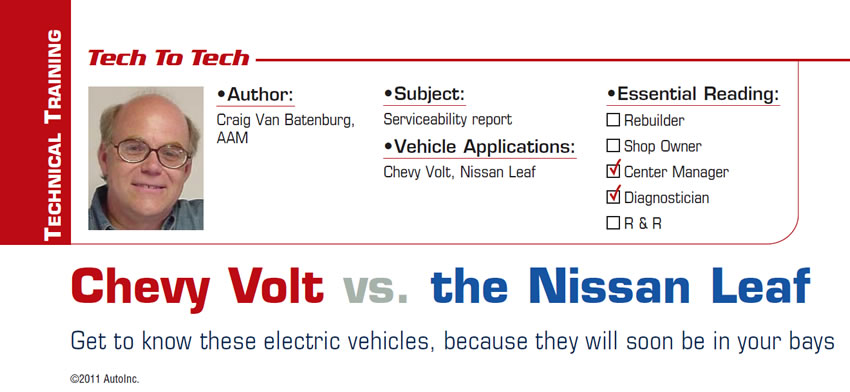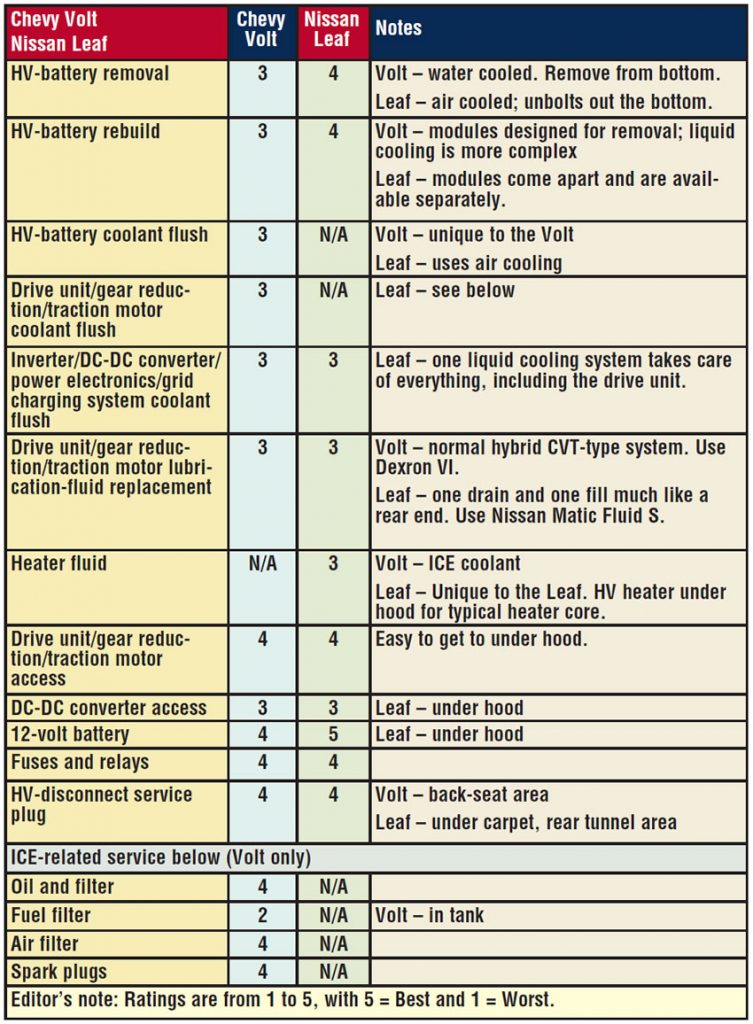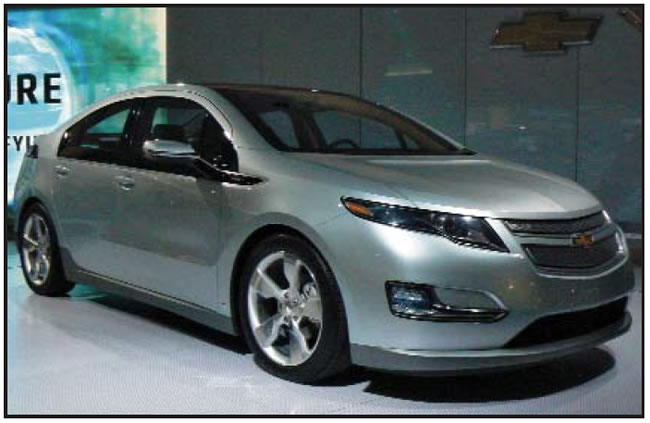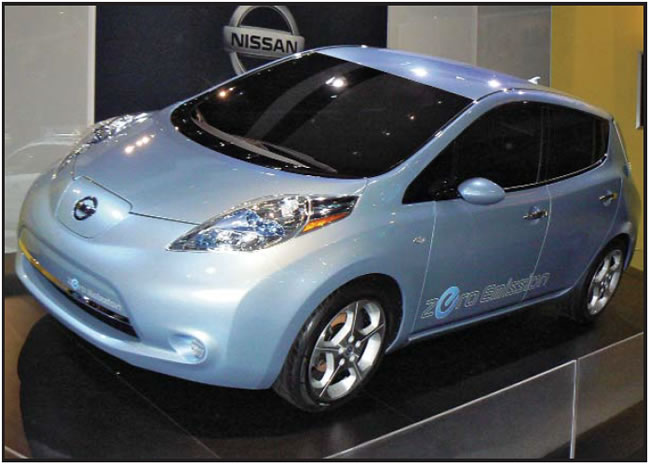
Tech to Tech
- Subject: Serviceability report
- Vehicle Applications: Chevy Volt, Nissan Leaf
- Essential Reading: Center Manager, Diagnostician
- Author: Craig Van Batenburg, AAM
Get to know these electric vehicles, because they will soon be in your bays
I have been at this a long time, writing about how a car company’s motor vehicles are built. More than 30 models have been reviewed in this column from the viewpoint of the technician. My minister, Rev. Aaron Payson, tells great stories, drives a Prius and remembers my name. What’s there not to like?
Last Sunday, it was his sermon about the owl that asked “why?” not “who?” that got me thinking. “Who” designed such a mess is less important than “why.” “Why” did so-and-so stick this part there? “Why” did a warranty item take two hours when a little thought would have made it a 10-minute job?
Frustration can be seen on every technician’s face from time to time. Will it ever end? Electric cars can give us the relief for which we have been waiting for more than 100 years. And it can start now.
The first two electric cars on the road today are the Nissan Leaf and Chevy Volt. The Leaf is pure electric (no gas tank), and the Volt is more of a plug-in hybrid. They are here, in the hands of a few early adopters. There is nothing to compare the old versus the new as we usually do, so we will compare them with each other.

Chevy Volt
Here is a brief overview of the Volt: It is a four-passenger, four-door hatchback with a large lithium-ion battery that you charge from a 110-volt wall socket, and it will drive without gas at highway speeds up to 40 miles. Then, a small internal-combustion engine (ICE) will automatically start and provide electricity to power the car, and the crankshaft will also directly link up in the transmission to provide power. Some of the information that continues to work its way into the Volt story and that is inaccurate is: “The gas engine will start after the battery runs out of charge and then recharge the battery and run the car.”

If General Motors Co. had decided to charge the high-voltage (HV) battery and drive the car, the fuel economy would have been horrible. As it is now, if your big battery is low on charge (20% or so) and you do not plug it in, the Environmental Protection Agency (EPA) says you will get 37 mpg combined city and highway – even if you never plug it in. If you drive it less than 40 miles in between plugging it in and fully charge the battery each time, it will never use gas (theoretically) and you will get an equivalent of 93 mpg. My company has a Volt on order and I will learn more as time goes on.
What about service? The Volt will change the way we suggest preventive maintenance. If Volt owners use their cars for short trips only and plug it in whenever they can, then according to GM the oil-change interval will be every two years. How will we know the actual mileage the ICE has run? Will scan-tool data tell us?
GM has installed an “oil change” light it says will monitor the oil-change issue. The evaporative-emission-control system (EVAP) gets tricky, and the gasoline in the tank can get stale. GM also wants Volt owners to use high-test fuel, and the vehicle has a specially designed, thick-walled steel gas tank. We have never serviced a car before that went thousands of miles without the engine running and still has an ICE.
What about the HV battery? It is designed to be rebuilt, and GM says the modules will be made available after the warranty is over. It is water cooled, so flushing will be required. The Volt has three separate cooling systems: ICE, power electronics and the HV battery. As this car has a complete hybrid drivetrain plus a large battery pack, you will have all the usual items to service and maintain, but when will they need it? That remains to be seen.
Nissan Leaf
Within a week of each other in December 2010, the first Leaf was delivered to a customer in California and the first Volt was delivered to its customer. In the late 1990s and early part of the past decade, California required many original-equipment manufacturers (OEMs) to sell electric vehicles (EV). But this time around, it is different. Today there is demand (how much remains to be seen), and yes, there is taxpayer money subsidizing the sales for the first 100,000 EVs for each maker. It was not known in 1999 whether hybrid cars would be a passing fad, as many predicted, or become part of mainstream technology.

We now have the answer, and many ASA-member shops service hybrids as they do any other car. Two million hybrids are on the roads, and Ford has overtaken Honda in hybrid sales in America. Who would have thought that would happen? If you would like to read more about EV technology, please see the June 2010 issue of AutoInc.
To start with, what is no longer an issue? No oil or filter change, no positive-crankcase-ventilation (PCV) system, no fuel filter, no timing belt or valve adjustment, no spark plugs or air filter. No exhaust system, no fuel injectors, no carbon to clean out or bad exhaust-gas-recirculation (EGR) valves. No torque converter, no shifting of gears, no clutch plate, no throw-out bearing or transmission. No EVAP, no fuel lines, no ignition coils or thermostat. No belts, no alternator, no pulleys and no gas tank. None of that will ever need service or repair again. The Chevy Volt still has most of those items.
What is new (these parts have been on hybrids since 1999 in America) that will need service and eventual repair? HV battery pack, inverter, HV three-phase brushless motor, DC-DC converter, HV cables, HV controllers, relays and more. What is new to EVs and plug-in HEVs are grid-charging components, electric heaters and more battery technologies. The Leaf has an air-cooled HV battery pack, but antifreeze is used to cool many HV parts.
Certainly there is a lot less to fix and maintain. There will be less work, but will the work that remains be harder? Less frustrating? Does less mean more room to work or will the technician’s space shrink so there is more room for people and their stuff? One thing that will never change is the amount of real estate a car starts out with. This is not a building where size doesn’t matter, and electric cars will be smaller than most to make the driving range longer. From my work on the Leaf so far, this is a very easy car to service. We will get our Leaf this year and report back later as we examine it more closely.
Summary
As more cars adopt HV systems of some sort, it will be our job to maintain, diagnose and repair them as the owners look to us for guidance and service. The electric car is never going to go away in our lifetime, nor will liquid-fueled internal-combustion engines. Young technicians say today, “Why would I ever want to work on a carburetor when fuel injection is so easy?” In the future, it will be, “Why would I ever want to work on a gasoline car when electric cars are so easy?”
Pure electric cars will be much easier to work on, I hope. The new designs can be much more technician friendly, but the engineers who design them will be the keepers of that dream. As a new decade unfolds, many eyes will be watching and maybe, just maybe, our day at work will get a little easier.
Ups (of a pure electric car): No gasoline fumes to breath. No gasoline fire hazard. No EVAP codes to fix. No exhaust to burn your flesh. More room under the hood. Something new to keep you interested. No need to ask your customer to bring it in low on fuel to replace the gas tank, because there is no gas tank.
Downs: Less work to do. HV can burn your flesh. Something new to drive you away from this industry.

Craig Van Batenburg, AAM, is the owner of the Automotive Career Development Center (ACDC), www.auto-careers.org, and delivers management and technical seminars nationwide. He formerly owned Van Batenburg’s Garage Inc. in Worcester, Mass., for more than 25 years. Van Batenburg is ASE master and L1 certified, with advanced skills in hybrid drive systems. You can reach him by e-mail at [email protected].
This copyrighted article is reprinted with the permission of AutoInc., the official publication of the Automotive Service Association (ASA). To learn more about ASA and its commitment to independent automotive-service and repair professionals, visit www.ASAshop.org or call 800-272-7467.













